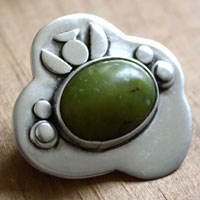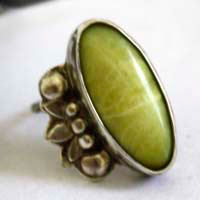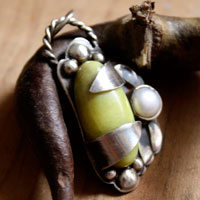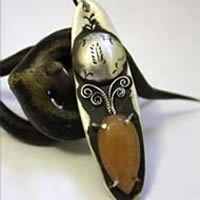- Jewelry
- Inspiration
- Good Deals
- Paintings
- About
- Contact
JEWELRY
- Anklet
- Bracelets
- Brooches
- Cufflinks
- Earrings
- Pendants & Necklaces
- Rings
- Draw your jewelry
- GOOD DEALS
- How to clean your jewel
- Metal we used
INSPIRATION
Aventurine: history, healing properties and lithotherapy

Aventurine properties

The origin of the name "aventurine" dates back to the accidental discovery of a particular type of glass in 18th-century Italy. The name comes from the Italian word "ventura", meaning "random" or "lucky." According to the story, an Italian glassmaker accidentally dropped copper filings into molten glass, thus creating a new type of crystal, very similar in color to our stone. This unexpected discovery was seen as a stroke of luck, hence the name "aventurine," associated with chance and fortune.
Also known as "Prase", derived from the Greek word meaning "leek," in reference to its distinctive green hue, aventurine offers a wealth of shades and meanings.
As a variety of quartz, aventurine is distinguished by mineral inclusions, particularly of fuchsite mica and hematite, which create a unique visual effect known as *aventurescence*. This phenomenon manifests as shimmering reflections, enhancing the visual appeal of the stone.
The color palette of aventurine is captivating and extends well beyond green. While green is the most common hue, thanks to the presence of fuchsite particles, other colors exist depending on the mineral inclusions:
- Green aventurine: derived from fuchsite, a chromium-rich mica.
- Blue aventurine: this rarer variety contains dumortierite, giving it bluish highlights.
- Red-brown aventurine: inclusions of hematite or goethite are responsible for the red or brown tones.
- Orange and yellow aventurine: iron oxides or mica create these warm shades.
The hardness of aventurine ranges between 6.5 and 7 on the Mohs scale, making it relatively durable and suitable for jewelry, although mineral inclusions can sometimes weaken certain parts. Its crystalline structure is trigonal, typical of quartz, and it forms through the cooling of silica in mineral-rich environments, creating the color variations and the shimmering effect.
Stories, legends and beliefs about the aventurine
Aventurine, with its deep historical roots, has been used for millennia. Rudimentary artifacts carved from this stone have been discovered in Ethiopia, dating back 2.5 million years, attesting to its early use.
The Etruscans associated it with Thalna, the goddess of childbirth.
The Romans linked it to Mercury, the god of commerce and luck. Roman soldiers sometimes wore aventurine as an amulet for protection in battle and to attract military success.
For the Chinese, aventurine was the sacred stone of Guanyin Pusa, the goddess of mercy, compassion, and unconditional love. It also played a major role in feng shui, where it was used to attract prosperity and promote financial well-being.
The Tibetans used aventurine to carve the eyes of their statues, bestowing them with a unique symbolic power. They also believed that wearing this stone improved vision, particularly for those suffering from myopia.
In Celtic culture, aventurine was seen as a magical stone that allowed connection with the forces of nature. Druids used it to invoke prosperity and strengthen their spiritual powers during rituals.
Today, aventurine is still recognized as the "stone of luck." Its reputation for fostering abundance, calming emotions, and supporting personal growth endures. Used as an amulet or in modern spiritual practices, it continues to captivate and bring a positive aura to those who wear it.

Mines: Russia, Brazil, Chili, Japan, Tanzania and India.
Healing properties and benefits of the aventurine
Aventurine, a stone with versatile properties, offers a wide range of benefits for both physical and mental health.
- Recognized for its effectiveness in treating heart conditions, it acts as a valuable support for cardiovascular health while also helping to regulate blood circulation for optimal circulatory system function.
- By promoting the growth of children and premature babies, it serves as a precious ally in physical development.
- Its stimulating role in cellular regeneration makes it an ideal stone for promoting healing and tissue revitalization. Its ability to aid in healing fractures is also acknowledged by some practitioners.
- Aventurine is particularly useful for urinary problems, including infections, prostate disorders, and even hemorrhoids, acting as a supportive stone for the urinary system.
- It is also known for calming neurological issues and insomnia, fostering mental balance and restorative sleep.
- With its gentle, soothing energy, aventurine helps reduce tension and anxiety while enhancing emotional resilience in the face of fears.
- Nicknamed the "stone of optimism," it infuses positive energy, bringing joy and renewal to those who wear it.
- It is especially useful for individuals under constant stress, acting as a natural calming remedy.
- By absorbing electromagnetic pollution, it offers protection against emissions from mobile phones and other electronic devices, helping to maintain a healthy environment.
- In elixir form, it provides beneficial effects for treating skin problems such as eczema, acne, and other skin conditions.
 Please note that all healing properties presented for gemstones are gathered from various sources. This information is provided as a service and is not intended to treat medical conditions. It is recommended to consult a healthcare professional for serious medical issues and not to rely solely on gemstones as a treatment.
Please note that all healing properties presented for gemstones are gathered from various sources. This information is provided as a service and is not intended to treat medical conditions. It is recommended to consult a healthcare professional for serious medical issues and not to rely solely on gemstones as a treatment.
Aventurine jewelry samples
To learn more about litotherapy, we recommend you the following books:










